
 |
||
|
Leroy Chiao (Ph.D.) NASA BIOGRAPHY Posted: September 16, 2000 PERSONAL DATA: Born August 28, 1960, in Milwaukee, Wisconsin, but considers Danville, California, to be his hometown. Single. He enjoys flying, basketball, racquetball, and skiing. EDUCATION: Graduated from Monte Vista High School, Danville, California, in 1978; received a bachelor of science degree in chemical engineering from the University of California, Berkeley, in 1983, and a master of science degree and a doctorate in chemical engineering from the University of California, Santa Barbara, in 1985 and 1987, respectively. SPECIAL HONORS: Invited to give technical seminars on honeycomb material and bonded panels, and cure modeling of aerospace composite materials, at the Beijing Institute of Aeronautical Materials, and at the Changsha Institute of Technology, 5th Department, in the Peoples Republic of China. Invited contributor to the International Encyclopedia of Composite Materials. Listed in Who's Who in Science and Engineering. Recipient of Distinguished Alumni Award from University of California, Santa Barbara. Keynote Commencement Speaker for the Departments of Engineering at the University of California at Berkeley, and at Santa Barbara, in 1996. EXPERIENCE: Dr. Chiao graduated in 1987 from the University of California at Santa Barbara, and joined the Hexcel Corporation in Dublin, California. He worked for Hexcel until 1989, during which time he was involved in process, manufacturing, and engineering research on advanced aerospace materials; worked on a joint NASA-JPL/Hexcel project to develop a practical, optically correct, precision segment reflector, made entirely of advanced polymer composite materials, for future space telescopes; as well as working on cure modeling and finite element analysis. In January of 1989 Dr. Chiao joined the Lawrence Livermore National Laboratory in Livermore, California, where he was involved in processing research for fabrication of filament-wound and thick-section aerospace composites. Dr. Chiao also developed and demonstrated a mechanistic cure model for graphite fiber/epoxy composite material. An instrument-rated pilot, Dr. Chiao has logged over 1500 flight hours in a variety of aircraft. NASA EXPERIENCE: Selected by NASA in January 1990, Dr. Chiao became an astronaut in July 1991. He is qualified for flight assignment as a mission specialist. His technical assignments to date include: Space Shuttle flight software verification in the Shuttle Avionics Integration Laboratory (SAIL); crew equipment, Spacelab, Spacehab and payloads issues for the Astronaut Office Mission Development Branch; Training and Flight Data File issues; EVA issues for the EVA Branch. A veteran of two space flights, he flew as a mission specialist on STS-65 in 1994 and STS-72 in 1996. Dr. Chiao has logged 567 hours, 55 minutes, 41 seconds in space, including two space walks totaling just over 13 hours. Dr. Chiao is assigned as a mission specialist on STS-92, the second Space Shuttle mission to assemble the International Space Station. Launch is scheduled for mid 2000. SPACE FLIGHT EXPERIENCE: STS-65 (July 8-23, 1994) launched from and returned to land at the Kennedy Space Center, Florida, setting a new flight duration record for the Space Shuttle program at that time. The STS-65 mission flew the second International Microgravity Laboratory (IML-2). During the 15-day flight the seven-member crew aboard Columbia conducted more than 80 experiments focusing on materials and life sciences research in microgravity. The mission was accomplished in 236 orbits of the Earth, traveling 6.1 million miles in 353 hours and 55 minutes. STS-72 (January 11-20, 1996) was a 9-day mission during which the crew aboard Endeavour retrieved the Space Flyer Unit (launched from Japan 10-months earlier), and deployed and retrieved the OAST-Flyer. Dr. Chiao performed two spacewalks designed to demonstrate tools and hardware, and evaluate techniques to be used in the assembly of the International Space Station. In completing this mission, Dr. Chiao logged a total of 214 hours and 41 seconds in space, including just over 13 EVA hours, and traveled 3.7 million miles in 142 orbits of the Earth.
|

|